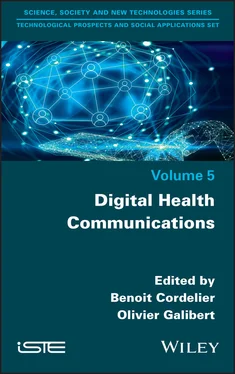Digital Health Communications
Здесь есть возможность читать онлайн «Digital Health Communications» — ознакомительный отрывок электронной книги совершенно бесплатно, а после прочтения отрывка купить полную версию. В некоторых случаях можно слушать аудио, скачать через торрент в формате fb2 и присутствует краткое содержание. Жанр: unrecognised, на английском языке. Описание произведения, (предисловие) а так же отзывы посетителей доступны на портале библиотеки ЛибКат.
- Название:Digital Health Communications
- Автор:
- Жанр:
- Год:неизвестен
- ISBN:нет данных
- Рейтинг книги:3 / 5. Голосов: 1
-
Избранное:Добавить в избранное
- Отзывы:
-
Ваша оценка:
- 60
- 1
- 2
- 3
- 4
- 5
Digital Health Communications: краткое содержание, описание и аннотация
Предлагаем к чтению аннотацию, описание, краткое содержание или предисловие (зависит от того, что написал сам автор книги «Digital Health Communications»). Если вы не нашли необходимую информацию о книге — напишите в комментариях, мы постараемся отыскать её.
Digital Health Communications — читать онлайн ознакомительный отрывок
Ниже представлен текст книги, разбитый по страницам. Система сохранения места последней прочитанной страницы, позволяет с удобством читать онлайн бесплатно книгу «Digital Health Communications», без необходимости каждый раз заново искать на чём Вы остановились. Поставьте закладку, и сможете в любой момент перейти на страницу, на которой закончили чтение.
Интервал:
Закладка:
The adjective “ sanitaire ” in French (literally meaning “sanitary” but translated as “health” used adjectivally in English) therefore has a hygienic and operational connotation that may seem more restrictive than the notion of “health”. The tensions surrounding this notion are not new: Guillotin and La Rochefoucault-Liancourt were already fighting in 1790 over the absorption of a begging committee by the health committee [EVI 02]. It may be difficult to distinguish between them and we can see that they are part of a continuum between abstraction and concrete practices. For this reason, and without precluding us from continuing our reflections and conceptualization efforts, we use expressions using these words interchangeably here.
Covid-19, caused by a coronavirus that has resulted in a global epidemic and an unprecedented wave of hospitalizations for patients with severe acute respiratory syndrome (SARS), is acting as a revealing, even accelerating, force for info-communication issues in the healthcare sector. Plunged into the heart of this health crisis, the world’s population is bombarded with journalistic information, as well as strategically targeted communications. In Quebec, during the daily press briefing at 1:00 p.m., François Legault (Premier of Quebec), along with the charismatic Dr. Horacio Arruda (National Director of Public Health) and other members of his cabinet, take stock and give directions for future actions. In France, during the 8 p.m. news, the usual media doctors appear with a myriad of hospital caregivers or epidemiologists who come to testify to the difficulty of coping with the influx of seriously ill patients, the need to remain confined to avoid the spread of an already highly volatile and contagious virus, or the shortage of intensive care beds and protective equipment available to caregivers.
The scientific and institutional expert voice is being solicited as never before, and is relayed or even instrumentalized by political actors in the battle of public opinion being played out in the background. The economic players of the digital society are becoming the universal mediators of a social link that circulates via WhatsApp or TikTok groups. Electronic socialization, which has been completely interwoven into our daily relationships since the massification of global multimedia mobility in the decade 2000–2010, initiated by Steve Jobs and his iPhone in 2008, hegemonically dominates all forms of relationships and information. In this sunny spring, we have resigned ourselves to exchanging and sharing information at a distance, often with humor, about the virus and how to protect ourselves from it: How can we get surgical masks by making them? How can we apply the distancing gestures that protect us from infection? What is the status of tests of promising treatments based on chloroquine or hydroxychloroquine? Are we taking a risk by continuing treatment with cortisone and other anti-inflammatory drugs?
Of course, emotions circulate just as much. Online communities can be formed in a matter of hours, not only within a family or a group of friends, but also within a neighborhood, a street or a building. Just as they serve as a digital foundation or for knowledge sharing between peers, so these communities are inseparable from the gregarious need that drives us: the need to keep in touch with our “local” or “distant” loved ones. Videoconferencing digital platforms are exploding in popularity as we try to maintain our professional activities or reinvent our relationships with family and friends from a distance. Between social, emotional and informational support, digital tools, just like the media of yesteryear, allow us today to create society.
In this spring of 2020, digital communication is everywhere, omnipresent, to the point of obscuring all other channels of mediation. Health issues are central, whether in exchanges on a daily life that reinvented its banality, or on the subject of socio-sanitary issues that were rarely confronted. However, the tensions linked to this massively health-related digital communication have not been swept away – quite the contrary. It would be tempting to give in to a technophilia that was already overwhelming in the past, yet that would be to quickly forget the darker side of the massive use of digital technology.
If we want to return, for example, to the circulation of health information on spaces dedicated to peer-to-peer communication, as all the major generalist social networks are (Twitter, Facebook, Instagram, etc.), the medical profession must face and deny a multitude of fake news stories. Open controversies of a new kind, such as the authorization (by a scientific fringe and a bureaucracy shaken in the temporality of their protocols) of the administration of a treatment not yet approved, are an opportunity for the diffusion in the public space of points of view with no other form of legitimization other than the recognition acquired on the Internet of those who share them.
The broadcasting and digital echo of the debate are part of the new creation of public opinion [CHA 90], which is quick to question any authorized speech. While this phenomenon is not exclusive to the health field, we do see the emergence of lay or amateur expertise [FLI 10]. And what about technological surveillance logics aimed at identifying and preventing, via smartphones, the physical contact of people diagnosed positive for Covid-19 through mobile geolocation applications?
Beyond the “general public” dimension of digital communication in healthcare, medical teams benefit from the creation of true communities of practice [COH 06] that enable them to share crucial knowledge about the disease. However, they are also confronted with the limitations of tools that cannot replace physical interactions, for example, during transmissions between night and day shifts in the hospital environment [GRO 98].
The same is true for local medicine. Although telemedicine allows private practitioners to maintain contact with patients with symptoms of Covid-19, particularly in certain territories already marked by the medical desert syndrome, these healthcare professionals nonetheless miss the accuracy of the diagnosis made possible by the traditional face-to-face consultation.
These healthcare professionals are also faced with the rediscovery of a digital divide that was thought to have been reduced by the quality of broadband telecom services, but these services are in fact still unevenly distributed across territories.
As a result, some rural areas, which have not yet been beneficiaries of fiber optic networks, find themselves penalized since videoconferencing services, necessary for remote consultation, require a very high data rate only possible with the installation of fiber.
P.1. The French and Quebec health systems as a heuristic context for analysis
As we will have understood, the spread of Covid-19 and its consequences, medical, economic, social and cultural, constitutes a pivotal moment in contemporary health information and communication issues in a digital context. It brings to the forefront both the consequences of a massive use of digital tools in medical practice and the no less central issues of increasingly digitalized interactions between patients and caregivers, between patients, and between caregivers.
The scope of health communication is therefore very broad. We can try to circumscribe it provisionally in a general definition. From our point of view, health communication encompasses all of the processes involved in creating, disseminating, sharing and evaluating information on health topics that are likely to affect the health of the public, or that are communicated in the organizational context of institutions or professional networks dedicated to health. Digital health communication concerns all health communication phenomena conveyed by sociotechnical information and communication dispositives (SICDs).
Читать дальшеИнтервал:
Закладка:
Похожие книги на «Digital Health Communications»
Представляем Вашему вниманию похожие книги на «Digital Health Communications» списком для выбора. Мы отобрали схожую по названию и смыслу литературу в надежде предоставить читателям больше вариантов отыскать новые, интересные, ещё непрочитанные произведения.
Обсуждение, отзывы о книге «Digital Health Communications» и просто собственные мнения читателей. Оставьте ваши комментарии, напишите, что Вы думаете о произведении, его смысле или главных героях. Укажите что конкретно понравилось, а что нет, и почему Вы так считаете.












